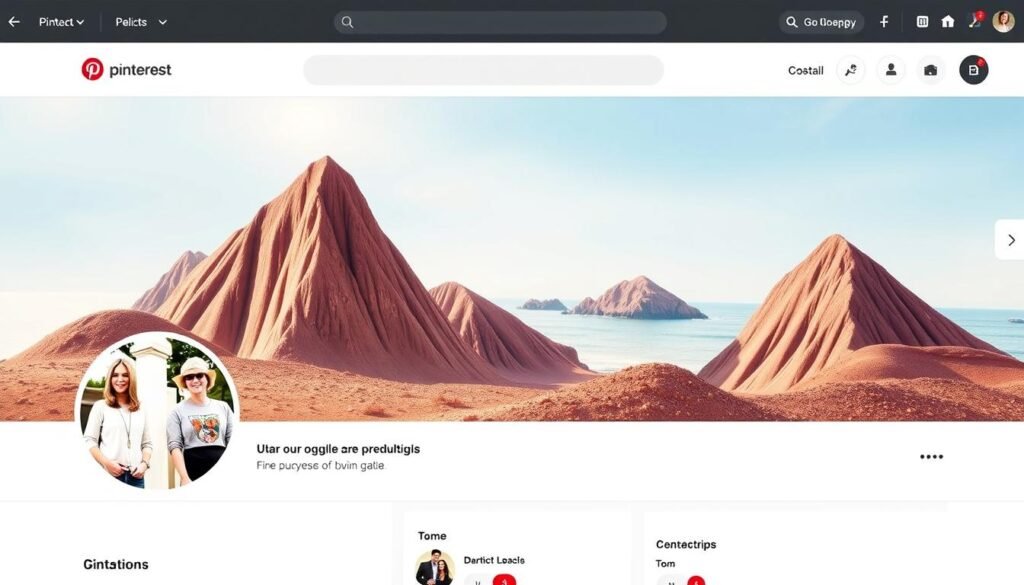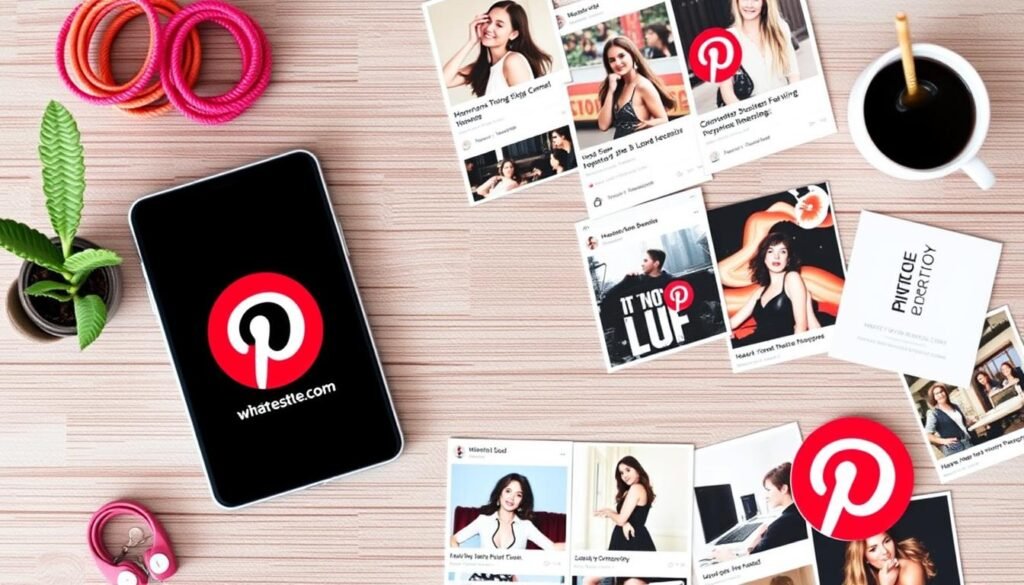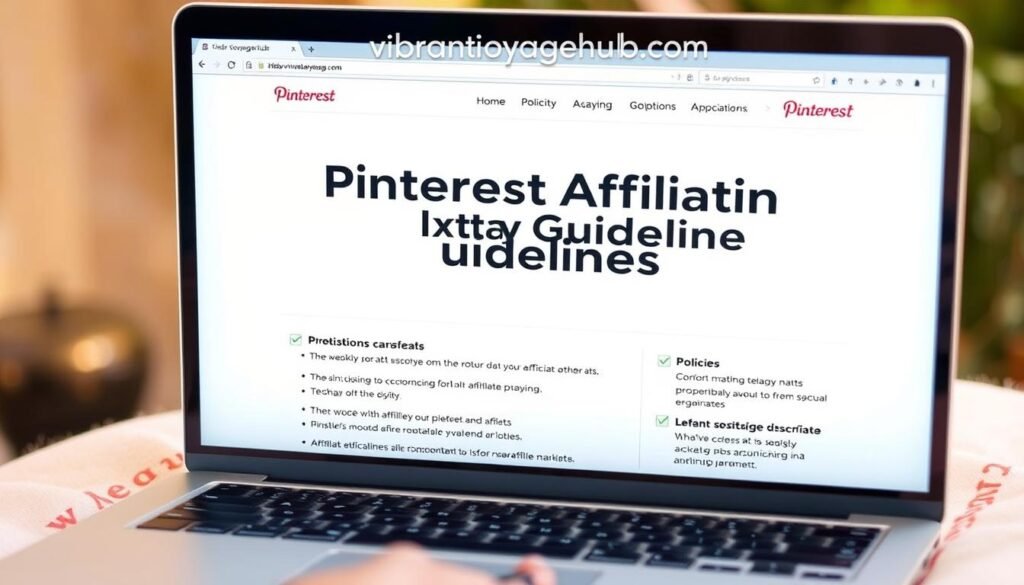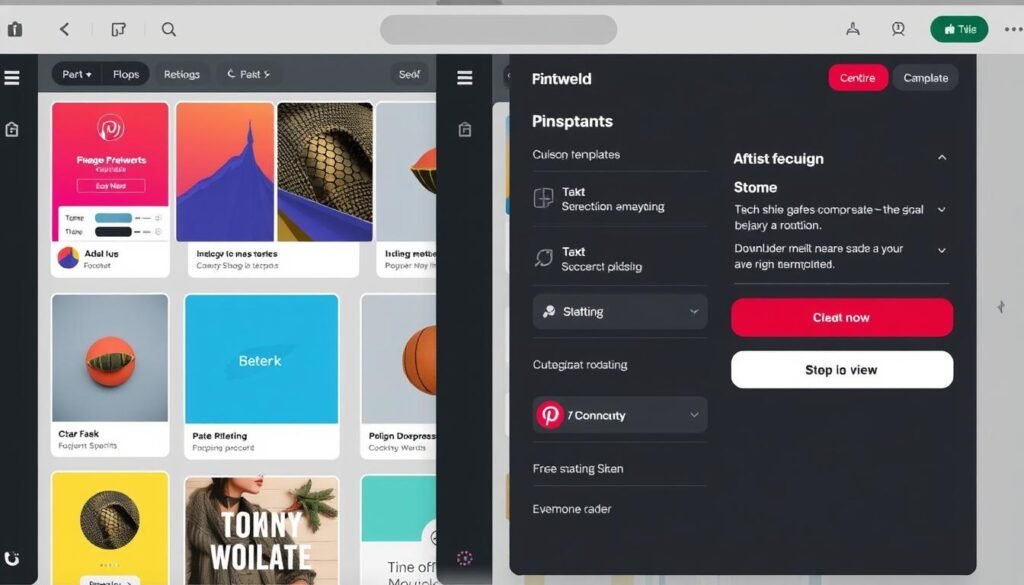Make Money with Pinterest Affiliate Marketing
Are you wondering if it’s possible to turn your Pinterest presence into a profitable venture? Unlike other social media platforms where users mindlessly scroll, Pinterest users are actively searching for ideas, products, and solutions, putting them in a buying mindset.
I will explore how Pinterest’s unique user behavior presents a significant opportunity for affiliate marketers to tap into an audience with high buying intent. With over 445 million monthly active users, the potential for earning commissions through affiliate links is substantial.
This comprehensive guide will walk you through the process of monetizing your Pinterest presence ethically and effectively, from setting up a business account to creating effective pins and implementing proven strategies for affiliate marketing success.
Key Takeaways
- Discover how to leverage Pinterest’s unique user behavior to boost your affiliate marketing efforts.
- Learn the steps to setting up a Pinterest business account for affiliate marketing success.
- Understand how to create effective pins that drive engagement and conversions.
- Explore proven strategies for implementing affiliate marketing on Pinterest.
- Find out how to monetize your Pinterest presence ethically and effectively.
What is Pinterest Affiliate Marketing?
As a visual search engine, Pinterest offers a unique platform for affiliate marketing. Pinterest is a platform where users can create and share content, known as Pins, and browse through others’ Pins to add to their boards. This platform is particularly well-suited for affiliate marketers due to its visual nature and the longevity of its content.
Pinterest’s affiliate marketing model allows users to earn commissions by promoting products or services through affiliate links. This is achieved by creating engaging Pins that link to the product or service, which can then be shared and saved by other users.
How Affiliate Marketing Works on Pinterest
Affiliate marketing on Pinterest works by creating Pins that contain affiliate links. When a user clicks on the Pin and makes a purchase, the affiliate marketer earns a commission. To succeed in Pinterest affiliate marketing, it’s essential to create high-quality, engaging Pins that resonate with your target audience.
The key to successful affiliate marketing on Pinterest is to understand how users interact with the platform. Unlike other social media platforms, Pinterest is a visual discovery and planning website, where users actively search for ideas, products, and solutions.
The Difference Between Pinterest and Other Social Platforms
Pinterest differs significantly from other social media platforms like Instagram, Twitter, or Facebook. While these platforms are primarily used for social interaction, Pinterest is focused on discovery and planning. As a result, Pinterest’s content has a longer shelf life, with Pins remaining visible and driving traffic for months or even years.
Pinterest users have different intent than users on other platforms—they’re actively searching for ideas, products, and solutions rather than passively consuming content. This makes Pinterest an ideal platform for affiliate marketers to reach users when they’re in a buying mindset.
Additionally, Pinterest’s board and collection system allows users to save and organize content for future reference, creating ongoing opportunities for affiliate links to be clicked. As Emily Wilson, a successful Pinterest affiliate marketer, notes, “Pinterest’s visual nature and long-term content visibility make it an attractive platform for affiliate marketers.”
Why Pinterest is Perfect for Affiliate Marketing
Affiliate marketers find Pinterest to be a haven due to its search-based discovery and enduring content presence. Unlike other social media platforms where content is fleeting, Pinterest’s unique ecosystem allows pins to remain visible and drive traffic for extended periods.
Pinterest Demographics and Buying Intent
Pinterest’s user base is characterized by a high buying intent, making it an attractive platform for affiliate marketers. According to recent statistics, a significant portion of Pinterest users have used the platform to make purchasing decisions. The platform’s demographics skew towards individuals looking for products and services to enhance their lifestyle, home, and personal style, aligning well with affiliate marketing strategies.
The search-based nature of Pinterest means that users are actively seeking content, which includes products and services that can be promoted through affiliate links. This proactive approach to content discovery contrasts with other platforms where users are often passively exposed to advertisements.
The Long Shelf Life of Pinterest Content
One of the standout features of Pinterest is the longevity of its content. Pins can continue to drive traffic and generate affiliate commissions months or even years after they are published. This is due to Pinterest’s search-based discovery system, which ensures that quality pins remain discoverable long after their initial publication.
The longevity of pins creates a compounding effect for affiliate marketers. Older pins continue to generate revenue while new pins add to overall earnings, creating a sustainable income stream. By focusing on creating “evergreen” pin content that remains relevant over time, marketers can maximize their long-term earning potential.
“The key to success on Pinterest is creating content that stands the test of time. By doing so, you can enjoy a passive income stream that continues to grow.”
To leverage this, affiliate marketers should prioritize creating high-quality, relevant content that will remain valuable to users over time. This approach not only enhances the visibility of pins but also contributes to a more stable and predictable income through affiliate marketing.
Setting Up Your Pinterest Business Account

Creating a Pinterest business account is essential for anyone looking to monetize their Pinterest presence through affiliate marketing. A business account provides access to analytics, advertising options, and other features crucial for success.
Creating a Business Profile vs. Personal Account
A business account on Pinterest differs significantly from a personal account, offering features like analytics and advertising that are vital for affiliate marketing success. With a business account, you can access Pinterest Analytics, which provides insights into your audience and content performance.
Optimizing Your Pinterest Profile for Affiliate Success
To maximize your Pinterest affiliate potential, optimizing your profile is crucial. This includes choosing a searchable username, crafting a keyword-rich bio, and creating relevant boards. Your profile should clearly communicate your niche and the value you offer to followers. Additionally, enabling Pinterest shopping and using rich pins can enhance your visibility and credibility.
By focusing on these profile enhancements, you can improve your discoverability on Pinterest and increase the effectiveness of your affiliate links. A well-optimized profile is key to successful Pinterest business operations.
Finding the Right Affiliate Programs for Pinterest

Identifying the most suitable affiliate programs is a critical step in Pinterest affiliate marketing. With numerous options available, it’s essential to choose programs that align with your niche and audience interests.
Pinterest gives you two main options for monetization: promoting your own products or services, and using Pinterest as a channel to drive traffic to third-party websites or other merchants. For affiliate marketing, the latter is more relevant.
Popular Affiliate Networks for Pinterest Marketers
Several affiliate networks are popular among Pinterest marketers. These include Amazon Associates, ShareASale, and Commission Junction. When selecting an affiliate network, consider factors such as commission rates, cookie durations, and the variety of products available.
For instance, Amazon Associates offers a vast range of products that can be promoted through Pinterest, making it easier to find relevant products for your audience. ShareASale and Commission Junction also host a wide array of products across various niches.
Choosing Products That Perform Well on Pinterest
Certain product categories tend to perform exceptionally well on Pinterest. These include fashion, home décor, beauty products, travel gear, and DIY supplies. When choosing products, consider their visual appeal, problem-solving capabilities, and aspirational value.
To identify trending products, use tools like Pinterest Trends. This helps in selecting products with high demand. Additionally, consider the price points of products to cater to different segments of Pinterest’s user base, from budget-friendly to luxury items.
Seasonal products can also be highly effective when promoted at the right time. Ensure that the products you choose have high-quality visual marketing assets, making it easier to create effective pins.
Understanding Pinterest’s Rules for Affiliate Marketing
As a Pinterest affiliate marketer, it’s vital to understand the platform’s community guidelines and disclosure requirements. Pinterest has specific rules in place to ensure a positive user experience and maintain the integrity of the platform.
Disclosure Requirements and FTC Guidelines
Pinterest requires affiliate marketers to disclose their affiliation with the product or service being promoted. This is in line with the Federal Trade Commission (FTC) guidelines, which mandate clear disclosure of affiliate relationships. To comply, you can use phrases like “affiliate link” or “sponsored” in your pin descriptions. For more information on FTC guidelines, you can visit Shopify’s blog on Pinterest affiliate marketing.
| Disclosure Method | Description | Example |
|---|---|---|
| Affiliate Link Disclosure | Clearly state that the link is an affiliate link | “This is an affiliate link, and I earn a commission if you make a purchase.” |
| Sponsored Content | Indicate that the content is sponsored | “Sponsored content: [Product Name]” |
Pinterest’s Community Guidelines for Affiliates
Pinterest’s community guidelines outline specific rules for affiliate marketers, including the requirement to post original content, avoid duplicate accounts, and refrain from manipulating the algorithm. You should also ensure that your pins meet Pinterest’s quality standards, providing value to users beyond just promoting products.

Some key guidelines to keep in mind include:
- Posting original content that adds unique value
- Avoiding duplicate accounts and content
- Refraining from manipulating the algorithm through mass pinning or other tactics
By following these guidelines, you can create effective affiliate content that complies with Pinterest’s rules and resonates with your audience.
Creating Effective Pins for Affiliate Marketing

Crafting effective pins is a vital step in leveraging Pinterest for affiliate marketing success. To maximize your affiliate earnings, you need to create pins that not only capture users’ attention but also drive sales. This involves understanding Pinterest’s visual landscape and optimizing your pins accordingly.
Pin Design Best Practices and Dimensions
When it comes to pin design, aesthetics and functionality are crucial. To stand out, your pins should be visually appealing and adhere to Pinterest’s recommended dimensions. Use high-quality images with a minimum size of 1000 x 1500 pixels, and ensure they are optimized for mobile devices. Infographics, product showcases, and lifestyle images work well, as they provide context and showcase products in action.
To make your pins more engaging, consider incorporating branding elements such as logos, color schemes, and typography that align with your website or product identity. This helps in building recognition and trust among potential customers.
Types of Pins That Drive Affiliate Sales
Different types of pins can be effective for driving affiliate sales, depending on your niche and audience. Some successful types include:
- Informative pins, such as infographics, that provide valuable information about products or services.
- Video pins that showcase products in action or offer tutorials.
- Catalogs for shoppable pins that categorize products and lead directly to your website’s product pages.
- Product in action pins that give users an idea of how to use or wear your products.
- Seasonally relevant pins that capitalize on current trends and interests.
By incorporating these types of pins into your Pinterest strategy, you can increase engagement, drive traffic to your affiliate links, and ultimately boost sales.
Make Money with Pinterest Affiliate Marketing Strategies
By leveraging the right Pinterest affiliate marketing strategies, you can significantly increase your affiliate earnings. To succeed in Pinterest affiliate marketing, it’s essential to implement a combination of strategies that drive traffic, boost engagement, and ultimately lead to conversions.
Creating Multiple Pins for Each Affiliate Product
Creating multiple pins for each affiliate product is a powerful strategy to increase your visibility and reach different segments of your audience. By diversifying your pins, you can test various images, descriptions, and calls-to-action to see what works best. This approach not only helps in avoiding repetition but also caters to different user preferences.
To create effective multiple pins, start by designing different visuals that highlight various aspects of the product. Use high-quality images and consider lifestyle shots that show the product in use. Additionally, craft unique descriptions that emphasize different benefits or features of the product. This variation keeps your content fresh and engaging for your audience.

Building an Email List Through Pinterest
Building an email list is a crucial strategy for Pinterest affiliate marketers, as it allows you to continue marketing to users beyond their initial pin engagement. According to Monica Lent, founder of Affilimate, capturing email addresses enables you to promote affiliate products through targeted email campaigns that educate and warm up potential buyers.
To build an email list, create effective landing pages with email opt-in forms and offer valuable lead magnets such as checklists, guides, or discount codes related to your affiliate niche. Once you have captured email addresses, nurture your subscribers with a series of educational emails and promotional content that eventually leads to affiliate purchases.
By combining Pinterest’s visual discovery capabilities with the direct communication of email marketing, you can create a powerful affiliate marketing system that maximizes conversions. This integrated approach ensures that you stay top of mind with your audience and can guide them through the buyer’s journey more effectively.
Experimenting with Different Pin Formats
Diversifying your pin formats can lead to improved performance in Pinterest affiliate marketing campaigns. To maximize your reach and engagement, it’s crucial to understand and leverage the different types of pins available on the platform.
Image Pins vs. Video Pins vs. Idea Pins
Pinterest offers a variety of pin formats, each with its unique benefits. Image pins are ideal for showcasing products with high-quality visuals. Video pins can be used to demonstrate products or share tutorials, providing a more dynamic experience. Idea pins, on the other hand, allow for multi-page content, making them perfect for sharing recipes, tutorials, or stories. By experimenting with these different formats, you can determine which type resonates best with your audience.
- Image pins: Perfect for static product images.
- Video pins: Great for product demos or tutorials.
- Idea pins: Ideal for multi-page content like recipes or stories.
Using Rich Pins and Product Tagging
Rich pins are an advanced feature on Pinterest that can automatically sync with your product data, making it easier for users to make informed purchasing decisions. By enabling rich pins, you can display extra information such as pricing and availability directly on the pin. To learn more about optimizing your Pinterest presence, visit our about page for additional resources.
To enable rich pins, you need to add metadata to your website and validate it through Pinterest’s Rich Pins Validator. The types of rich pins available include product, recipe, and article pins, each catering to different niches and content types.

Product tagging is another powerful feature that allows you to create shoppable pins, streamlining the path to purchase for your affiliate products. By tagging products directly in your pins, you can enhance the user experience and potentially increase conversions.
Pinterest SEO: Getting Your Affiliate Pins Discovered
Pinterest SEO plays a vital role in getting your affiliate pins discovered by the right audience. With millions of users on Pinterest, optimizing your content for search can significantly increase your visibility and drive traffic to your affiliate links.
Keyword Research for Pinterest
Effective keyword research is the foundation of a successful Pinterest SEO strategy. To start, you need to identify the keywords your target audience is searching for. This involves understanding their interests, needs, and pain points. You can use tools like Pinterest’s auto-complete feature, Google Keyword Planner, or third-party SEO tools to find relevant keywords.
Once you have a list of potential keywords, analyze their search volume and competition. Focus on long-tail keywords that are more specific and less competitive. For example, instead of targeting “health supplements,” you might target “women’s health supplements” or “probiotics for women.”
| Keyword | Search Volume | Competition |
|---|---|---|
| Women’s health supplements | 1,000 | Low |
| Probiotics for women | 500 | Medium |
| Health supplements | 10,000 | High |
Optimizing Pin Descriptions and Titles
After conducting keyword research, it’s time to optimize your pin descriptions and titles. Your pin title should be attention-grabbing and include your target keyword. Keep it concise, ideally under 100 characters, to ensure it displays fully in search results.
For pin descriptions, provide valuable information about the product or service you’re promoting. Naturally incorporate your target keywords, but make sure the description is compelling and encourages users to click through. Include a clear call-to-action (CTA) to drive traffic to your affiliate link. For example: “Discover the benefits of probiotics for women’s health. Click to learn more and get exclusive discounts
When optimizing pin descriptions, also consider including relevant hashtags to increase discoverability. However, use them sparingly and ensure they are directly related to your content.
Growing Your Pinterest Affiliate Marketing Reach
Growing your Pinterest affiliate marketing reach requires a combination of community engagement and smart pin scheduling. To maximize your affiliate earnings, it’s essential to expand your audience and increase your pin’s visibility.
Leveraging Group Boards and Communities
One effective way to grow your reach is by participating in group boards related to your niche. Group boards allow multiple users to pin content to a single board, increasing the visibility of your affiliate pins. To leverage group boards, first, find relevant boards by searching for keywords related to your affiliate products. Then, request to join these boards and follow their rules for contributors. By doing so, you can tap into an existing audience interested in your niche.
For instance, if you’re promoting outdoor gear, join group boards focused on hiking or camping. This targeted approach ensures your content reaches users who are more likely to engage with your affiliate pins.
| Group Board Type | Description | Benefits |
|---|---|---|
| Niche-specific | Boards focused on a specific topic or niche. | Targeted audience, higher engagement. |
| General Interest | Boards covering a broad range of topics. | Diverse audience, potential for broader reach. |
Scheduling Pins and Consistency Strategies
Scheduling your pins in advance is a time-saving strategy that ensures consistency, a key factor in Pinterest’s algorithm. Tools like Tailwind, Later, and Hootsuite allow you to automate your pinning schedule, ensuring your content is posted at optimal times when your audience is most active.
To maximize the effectiveness of pin scheduling, create a content calendar that incorporates seasonal trends, shopping events, and product launches relevant to your affiliate marketing niche. Batching pin creation and scheduling can also help maintain quality while maximizing efficiency.
“Consistency is key to maintaining a strong presence on Pinterest. By scheduling your pins, you can ensure a regular flow of content that keeps your audience engaged.”
By leveraging group boards and maintaining a consistent pinning schedule, you can significantly grow your Pinterest affiliate marketing reach and drive more traffic to your affiliate links.
Essential Tools for Pinterest Affiliate Marketing
Maximizing your Pinterest affiliate marketing potential requires a combination of the right strategies and tools. To succeed, you’ll need to leverage various tools that can help you create engaging content, schedule pins, and analyze your performance.

Scheduling and Analytics Tools
To streamline your Pinterest affiliate marketing efforts, you’ll need scheduling and analytics tools. Tools like Tailwind and Hootsuite allow you to schedule your pins in advance, ensuring consistency and saving time. Additionally, analytics tools like Pinterest Analytics and Google Analytics help you track your performance, understand your audience, and make data-driven decisions.
Design and Content Creation Tools
Creating high-quality, engaging content is crucial for Pinterest affiliate marketing success. Design tools like Canva, Venngage, and Adobe Photoshop enable you to create professional-looking pins, infographics, and other visual content. Canva, in particular, offers Pinterest-specific templates that are optimized at 1000x1500px, making it easy to create content that resonates with your audience. You can also use Canva’s stock photos and design assets to enhance your content and make sure it stands out.
By leveraging these essential tools, you can enhance your Pinterest affiliate marketing efforts, increase your reach, and drive more sales. Whether you’re creating content, scheduling pins, or analyzing your performance, the right tools can make a significant difference in your success.
Tracking and Analyzing Your Pinterest Performance
As a Pinterest affiliate marketer, tracking your performance is essential to making data-driven decisions. To optimize your affiliate marketing efforts, you need to understand how your pins are performing and how users are interacting with your content.
Key Metrics to Track in Pinterest Analytics
To gauge your success on Pinterest, focus on key metrics such as engagement rates, click-through rates, and conversion metrics. These metrics will help you identify your top-performing affiliate pins and understand what resonates with your audience. Make sure to monitor your Pinterest Analytics regularly to catch trends and patterns in your data.
Some key metrics to track include:
- Impressions and clicks on your affiliate pins
- Engagement rates, including saves, comments, and shares
- Conversion rates and earnings from your affiliate links
Promoting High-Performing Pins
Once you’ve identified your top-performing affiliate pins, you can amplify their reach using Pinterest’s paid promotion features. Promoting high-performing pins together with organic pins can drive more traffic and grow your audience. Use sponsored pins to promote an affiliate link directly or drive users back to your affiliate marketing content.
To maximize the impact of your promoted pins, consider the following strategies:
- Targeting options to reach your desired audience
- Budget considerations to ensure you’re getting the best ROI
- Bid strategies to optimize your ad spend
By tracking your performance and promoting high-performing pins, you can refine your Pinterest affiliate marketing strategy and increase your earnings.
Conclusion
As we conclude our journey through the world of Pinterest affiliate marketing, it’s clear that this platform offers a unique opportunity for affiliate marketers. Unlike other social media platforms, Pinterest users are actively searching for ideas, products, and solutions, making it an ideal place to monetize content with affiliate links.
The key to successful Pinterest affiliate marketing lies in providing value, creating high-quality content, and building trust with your audience. By doing so, you can turn your pins into a source of passive income. It’s essential to follow Pinterest’s guidelines and FTC regulations to ensure long-term success and avoid account restrictions.
To get started with Pinterest affiliate marketing, begin by setting up a Pinterest business account, which provides access to analytics and other business features. Then, focus on creating effective pins that resonate with your audience. You can explore various pin formats, such as image pins, video pins, and idea pins, to see what works best for your content. For more detailed guidance, you can refer to resources like this comprehensive guide on Pinterest affiliate marketing.
One of the significant advantages of Pinterest affiliate marketing is its potential for both immediate and long-term passive revenue. Since pins can remain relevant and continue to drive traffic over time, your efforts can yield ongoing returns. However, it’s crucial to stay updated with the latest trends and best practices in affiliate marketing to maximize your earnings.
In conclusion, Pinterest affiliate marketing is a powerful strategy that can be a valuable part of a diversified affiliate marketing approach. By dedicating time to learning and adapting to the evolving landscape, you can unlock the full potential of this platform. Start implementing the strategies outlined in this article, and you’ll be on your way to turning your Pinterest account into a profitable venture.
FAQ
What are the benefits of using a business account on Pinterest for affiliate marketing?
Using a business account on Pinterest provides access to analytics, advertising options, and the ability to use rich pins, which can enhance your affiliate marketing efforts.
How do I disclose my affiliation with a product on Pinterest?
To comply with FTC guidelines, I clearly disclose my affiliation with a product in my pin description, using phrases like “#ad” or “#affiliate.”
What types of pins are most effective for affiliate marketing on Pinterest?
I find that visually appealing image pins, video pins, and idea pins can drive affiliate sales, as they allow me to showcase products in a compelling way.
Can I use Pinterest’s promoted pins for affiliate marketing?
While Pinterest’s promoted pins can be effective, I ensure that I comply with Pinterest’s guidelines and disclose my affiliation with the product being promoted.
How do I optimize my Pinterest profile for affiliate success?
To optimize my profile, I use relevant keywords, a clear profile picture, and a compelling bio that includes a link to my website or other relevant content.
What are some essential tools for Pinterest affiliate marketing?
I use scheduling and analytics tools like Tailwind, design tools like Canva, and content creation tools like Adobe Creative Cloud to streamline my affiliate marketing efforts.
How do I track the performance of my affiliate pins on Pinterest?
I use Pinterest analytics to track key metrics like impressions, clicks, and engagement, which helps me refine my affiliate marketing strategy.
Can I join multiple affiliate programs on Pinterest?
Yes, I can join multiple affiliate programs, but I ensure that I comply with each program’s guidelines and disclose my affiliation with the products being promoted.
editor's pick
latest video
news via inbox
Nulla turp dis cursus. Integer liberos euismod pretium faucibua




